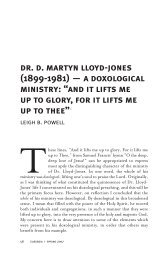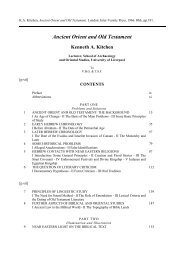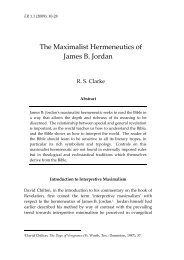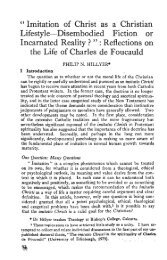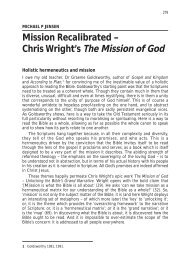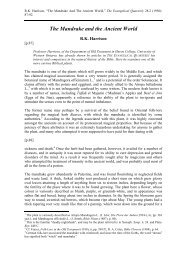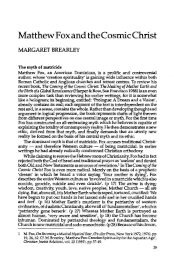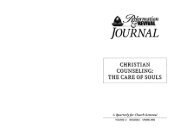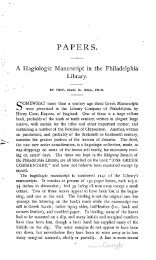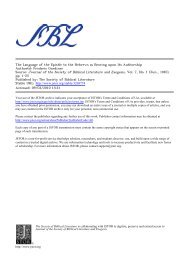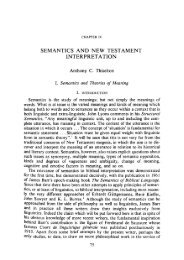Lutheranism in Russia and the Soviet Union: Another Response to ...
Lutheranism in Russia and the Soviet Union: Another Response to ...
Lutheranism in Russia and the Soviet Union: Another Response to ...
Create successful ePaper yourself
Turn your PDF publications into a flip-book with our unique Google optimized e-Paper software.
250 Gerd Stricker<br />
<strong>to</strong> <strong>the</strong> Swedish Lu<strong>the</strong>ran Church (from 1617 until about 1700).8 When Ingermanl<strong>and</strong><br />
became part of <strong>the</strong> <strong>Russia</strong>n Empire <strong>the</strong> Ingermanl<strong>and</strong>ers were, it is true, separated from<br />
Sweden <strong>and</strong> from <strong>the</strong>ir F<strong>in</strong>nish k<strong>in</strong>, but until 1917 most of <strong>the</strong>ir pas<strong>to</strong>rs came from<br />
F<strong>in</strong>l<strong>and</strong>; <strong>the</strong> Ingermanl<strong>and</strong>ers among <strong>the</strong>m had done <strong>the</strong>ir <strong>the</strong>ological studies <strong>in</strong> Hels<strong>in</strong>ki.<br />
What is more, after <strong>the</strong>y were <strong>in</strong>corporated by <strong>the</strong> <strong>Russia</strong>n bureaucracy <strong>in</strong><strong>to</strong> <strong>the</strong> ELCR<br />
(founded <strong>in</strong> 1832) <strong>the</strong>y still rema<strong>in</strong>ed orientated <strong>to</strong>wards F<strong>in</strong>l<strong>and</strong> <strong>and</strong> <strong>to</strong>ok little <strong>in</strong>terest <strong>in</strong><br />
what was go<strong>in</strong>g on <strong>in</strong> <strong>the</strong> united church <strong>to</strong> which <strong>the</strong>y now officially belonged. The<br />
Ingermanl<strong>and</strong>ers had no <strong>in</strong>fluence of any k<strong>in</strong>d on <strong>the</strong> Lu<strong>the</strong>ran Church <strong>in</strong> <strong>the</strong> <strong>Russia</strong>n<br />
Empire.<br />
Statistics for 1914 for <strong>the</strong> Lu<strong>the</strong>ran Church <strong>in</strong> <strong>Russia</strong> 9 reveal <strong>the</strong> Ingermanl<strong>and</strong>ers <strong>and</strong><br />
F<strong>in</strong>ns as very small groups <strong>in</strong> <strong>the</strong> united church (Meyer, 1918, p. 98). Out of 3.7 million<br />
members 1.3 million were Latvians, 1.1 million Es<strong>to</strong>nians, 1.1 million Germans (200,000<br />
Baltic Germans <strong>and</strong> 900,000 <strong>Russia</strong>n Germans <strong>in</strong> <strong>the</strong> rest of <strong>the</strong> <strong>Russia</strong>n Empire), <strong>and</strong> just<br />
145,000 F<strong>in</strong>ns <strong>and</strong> Ingermanl<strong>and</strong>ers. The parishes <strong>in</strong> Ingermanl<strong>and</strong> were divided amongst<br />
three deaneries (Propsteibezirke) (Schliisselburg, Ost-Ingermanl<strong>and</strong> <strong>and</strong> West-Ingermanl<strong>and</strong>)<br />
(Amburger, 1998, p. 100) compris<strong>in</strong>g 21 parishes (with some 50-60 branches <strong>in</strong><br />
small villages); <strong>the</strong>y were under <strong>the</strong> jurisdiction of a special Ingermanl<strong>and</strong>er provost or<br />
dean (lngermanliider Oberkirchenvorsteheramt). The Marienkirche near Nevsky Propekt<br />
<strong>in</strong> St Petersburg had a congregation of 15,000 F<strong>in</strong>ns <strong>and</strong> 2400 Ingermanl<strong>and</strong>ers (1890).<br />
This figure should be compared with 55,000-60,000 Germans <strong>in</strong> St Petersburg alone, as<br />
well as ano<strong>the</strong>r few thous<strong>and</strong> colonists <strong>in</strong> German villages <strong>in</strong> St Petersburg gubemiya. 10<br />
In <strong>the</strong> <strong>Soviet</strong> <strong>Union</strong><br />
The Oc<strong>to</strong>ber Revolution of 1917 concentrated most of <strong>the</strong> Es<strong>to</strong>nians <strong>and</strong> Latvians <strong>in</strong> <strong>the</strong>ir<br />
new states. Es<strong>to</strong>nia was formed from <strong>the</strong> old prov<strong>in</strong>ce of Estl<strong>and</strong> <strong>and</strong> nor<strong>the</strong>rn Livl<strong>and</strong>,<br />
Latvia from sou<strong>the</strong>rn Livl<strong>and</strong>, Courl<strong>and</strong> <strong>and</strong> <strong>the</strong> hi<strong>the</strong>r<strong>to</strong> Polish (<strong>and</strong> hence Catholic)<br />
Latgalia. Meanwhile <strong>the</strong> border changes meant that several tens of thous<strong>and</strong>s of Es<strong>to</strong>nians<br />
<strong>and</strong> Latvians found <strong>the</strong>mselves <strong>in</strong> <strong>the</strong> <strong>Soviet</strong>-Baltic border country, this time on <strong>the</strong> <strong>Soviet</strong><br />
side. The Ingermanl<strong>and</strong>ers <strong>in</strong> Petrograd gubemiya were cut off from <strong>the</strong>ir cultural centres<br />
<strong>in</strong> F<strong>in</strong>l<strong>and</strong> by <strong>the</strong> now almost impermeable frontier. Fila<strong>to</strong>v is wrong when he says that<br />
<strong>the</strong> ELCR" ceased its activities dur<strong>in</strong>g <strong>the</strong> turmoil of war, revolution <strong>and</strong> civil war. In<br />
1918 it moved its adm<strong>in</strong>istrative headquarters from Petrograd <strong>to</strong> Moscow. In 1920 a<br />
provisional synod produced Temporary Regulations (Temporiire Bestimmungen) (for <strong>the</strong><br />
text see Stupperich, 1959, pp. 223-30) with which it sought <strong>to</strong> react <strong>to</strong> <strong>the</strong> new political,<br />
statistical <strong>and</strong> geographical circumstances. The church had lost its 337 Baltic parishes:<br />
more than 670 churches al<strong>to</strong>ge<strong>the</strong>r (<strong>in</strong>clud<strong>in</strong>g all <strong>the</strong>ir branches). In 1924 a General Synod<br />
of <strong>the</strong> church <strong>the</strong>n produced a new Constitution (Stupperich, 1959, pp. 231-43).<br />
A survey from 1922 (Kahle, 1974, pp. 505-10) gives <strong>the</strong> follow<strong>in</strong>g church structure.<br />
The <strong>to</strong>p church body was <strong>the</strong> Bishops' Council (Bischofsrat). This replaced <strong>the</strong> earlier<br />
General Consis<strong>to</strong>ry (Generalkonsis<strong>to</strong>rium). To this were subord<strong>in</strong>ated Higher Church<br />
Councils (Oberkirchenriite) (HCCs) <strong>to</strong> run <strong>the</strong> parishes <strong>in</strong> <strong>the</strong> various regions of <strong>the</strong> <strong>Soviet</strong><br />
<strong>Union</strong>. Oberkirchenrat was <strong>the</strong> new name for Konsis<strong>to</strong>rium as <strong>the</strong> body <strong>in</strong> charge of an<br />
ethnically def<strong>in</strong>ed church region, or diocese (Bistum). Each HCC was <strong>to</strong> be headed by a<br />
bishop. The geographical areas under <strong>the</strong> jurisdiction of <strong>the</strong> HCCs varied greatly <strong>in</strong> size<br />
s<strong>in</strong>ce <strong>the</strong> ma<strong>in</strong> criterion for <strong>the</strong> church leadership was <strong>the</strong> national one. The aim was that<br />
<strong>the</strong> national m<strong>in</strong>orities should feel <strong>the</strong>mselves adequately represented by <strong>the</strong>ir own HCC.<br />
There were two German HCCs (Moscow <strong>and</strong> PetrogradlLen<strong>in</strong>grad) (147 so-called<br />
'Kirchspiele' with some 1300 branches), a Latvian HCC (five Kirchspiele with some 25




